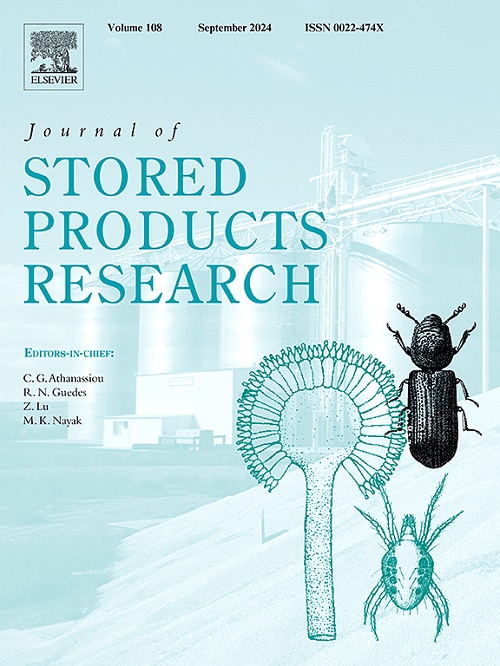Insecticidal effects of substances from cinnamon bark – eugenol, trans-cinnamaldehyde and cinnamaldehyde on Tenebrio molitor (Coleoptera: Tenebrionidae)
IF 2.7
2区 农林科学
Q1 ENTOMOLOGY
引用次数: 0
Abstract
The use of synthetic pesticides is increasingly limited due to their environmental impact, development of pest resistance, and confirmed negative effects on human health. At the same time, the demand for food grown in accordance with the principles of organic farming is increasing. Integrated Pest Management (IPM) promotes the use of biopesticides - natural substances with low toxicity to nontarget species as alternatives to synthetic pesticides. These substances include, among others, compounds found in the bark of the Ceylon cinnamon tree (Cinnamomum verum J. Presl, Lauraceae), such as eugenol, trans-cinnamaldehyde and cinnamaldehyde. However, the mechanism of their action has not been sufficiently researched. Therefore, this study compared the effects of these substances and various modes of their application on important pests of cereal crops and food stores and on a model organism, Tenebrio molitor beetle (Coleoptera: Tenebrionidae). The tested compounds were administered by injection, inhalation, food, by immersing the tested larvae or by contacting them with substratum soaked in the tested compound. The results allowed us to determine the LT50 parameter, and the probit analysis estimated the LC20/30/50/95 values. The results showed that the most effective route for administering cinnamon bark compounds is contact and injection, and the most effective compound is eugenol, with an LC50 value of 2.01 μl/ml (contact). The lowest LC50 values for trans-cinnamaldehyde and cinnamaldehyde were 6.28 μl/ml (injection) and 15.66 μl/ml (contact), respectively. Second, cinnamaldehyde and trans-cinnamaldehyde (filter paper tests at 200 μl/ml) and eugenol (immersion test at 300 μl/ml) had the lowest LT50 values. The test results also indicate that all the tested compounds cause morphological malformations in T. molitor larvae in the concentration range of 50–300 μl/ml. This research highlights the insecticidal potential of eugenol and cinnamaldehydes, indicating that cinnamon bark-derived pesticides could effectively control T. molitor populations. These compounds are promising for developing eco-friendly biopesticides.
肉桂皮中丁香酚、反式肉桂醛和肉桂醛对黄粉甲的杀虫效果(鞘翅目:黄粉甲科)
合成农药的使用日益受到限制,因为它们对环境造成影响,对害虫产生抗药性,并已证实对人类健康有负面影响。与此同时,对按照有机农业原则种植的食物的需求正在增加。有害生物综合治理(IPM)提倡使用生物农药——对非目标物种毒性低的天然物质作为合成农药的替代品。这些物质包括在锡兰肉桂树(Cinnamomum verum J. Presl,樟科)树皮中发现的化合物,如丁香酚、反式肉桂醛和肉桂醛。然而,对其作用机制的研究还不够充分。因此,本研究比较了这些物质及其不同施用方式对谷类作物和粮食储藏的重要害虫以及对模式生物黄粉甲(鞘翅目:黄粉甲科)的影响。通过注射、吸入、食物、浸泡被试幼虫或将其与浸泡在被试化合物中的基质接触的方式给药。结果使我们能够确定LT50参数,probit分析估计LC20/30/50/95值。结果表明,肉桂皮化合物的给药途径为接触和注射,其中丁香酚最有效,LC50值为2.01 μl/ml(接触)。反式肉桂醛和肉桂醛的最低LC50值分别为6.28 μl/ml(注射)和15.66 μl/ml(接触)。其次,肉桂醛、反式肉桂醛(滤纸浓度为200 μl/ml)和丁香酚(浸液浓度为300 μl/ml)的LT50值最低。试验结果还表明,在50 ~ 300 μl/ml浓度范围内,所有化合物均可引起褐皮蛾幼虫形态畸形。本研究强调了丁香酚和肉桂醛的杀虫潜力,表明肉桂皮衍生农药可以有效地控制野田鼠种群。这些化合物有望用于开发生态友好型生物农药。
本文章由计算机程序翻译,如有差异,请以英文原文为准。
求助全文
约1分钟内获得全文
求助全文
来源期刊
CiteScore
5.70
自引率
18.50%
发文量
112
审稿时长
45 days
期刊介绍:
The Journal of Stored Products Research provides an international medium for the publication of both reviews and original results from laboratory and field studies on the preservation and safety of stored products, notably food stocks, covering storage-related problems from the producer through the supply chain to the consumer. Stored products are characterised by having relatively low moisture content and include raw and semi-processed foods, animal feedstuffs, and a range of other durable items, including materials such as clothing or museum artefacts.

 求助内容:
求助内容: 应助结果提醒方式:
应助结果提醒方式:


